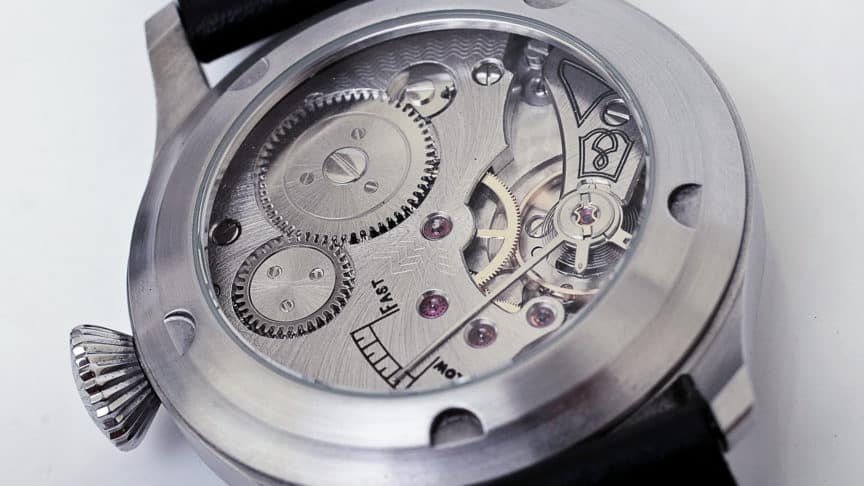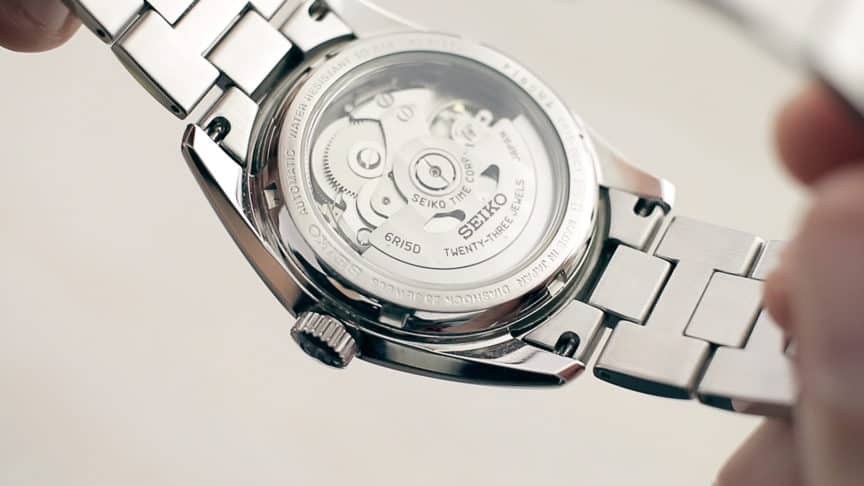Overwind I Can Do It Again
Near modern automatic watches today tin exist paw-wound. So practise all hand-wound (only) mechanical watches. But if you're just started as a watch enthusiast, it can be hard to know what you should or shouldn't exercise, and if you can overwind a watch.
Tin you lot overwind a picket? You tin can't over-wind modernistic automatic watches. The winding mechanism will simply decouple from the mainspring when information technology is fully wound, winding into infinity. This is when you should stop winding your sentinel.
Beware of depression quality and very quondam lookout: they can however use older mechanisms that were not designed to protect the mainspring from over-winding.
Manual winding watches will let you lot know when the mainspring is fully wound: you volition feel a resistance and the winding stem will stop moving.
Brand certain to know exactly what type of spotter you have before winding it manually, too well every bit the consequences of winding it completely and what are the causes if it stops.
The difference betwixt an automatic and a manual winding watch
First of all: transmission winding and automatic watches are both mechanical watch. Significant, they feature a consummate mechanical machinery (called motility) that runs the watch.
None of them require a battery, as the power needed for a mechanical motility to run is stored in the mainspring.
In order for the mainspring to deliver power, it has to exist wound. This is done either by hand or automatically, depending on the type of mechanical spotter.
A manual winding watch is a mechanical that you have to wind by hand for the motion to start running (hence the name). Depending on the power reserve of the watch and how much you wound the mainspring, the sentry will finish sooner or afterwards.
In order to go along it running, you will have to air current it at regular intervals.

On the other manus,an automated watch features a mechanism that winds the mainspring automatically when you are wearing the watch. The motility of your arm and wrist will put your watch in different positions.
Meanwhile, a weighted rotor inside the watch will e'er balance itself due to gravity. By doing and then, information technology will make a part of the mechanism motility in club to automatically wind the mainspring.

If you keep your automatic watch on your wrist all 24-hour interval long, remove it for the night, and then put it again on your wrist the next morning, your automatic watch volition run forever without you doing anything.
This is because the ability reserve of a mechanical watch is 38 hours or more.
Tin automated watches be over-wound?
No, they can't. Automatic watches accept a mechanism that winds the mainspring every fourth dimension y'all move, but only if information technology'southward non already fully wound. When the mainspring is fully wound, the rotor inside the watch will stop spinning in the management in which it winds the mainspring.
Because you are moving your arm all day long, lookout manufacturers had to find a style to forestall yous from accidentally over-winding the mainspring.
You just can't control the amplitude and amount of your movements all twenty-four hours every day, correct?
What about hand winding an automatic picket, and so? Some automatic watch can't be hand-wound (the Seiko SKX013 is a notable instance – read my full review hither), but nearly tin.
Tin can yous over-wind your precious automatic timepiece past hand?
No you can't. If the mainspring is not fully wound, then turning the crown (the outer part of the movement continued to the winding stem) volition simply air current the mainspring as it should.
If the mainspring is already full wound, turning the crown will have no effect. Equally a affair of fact, the mechanism will disengage the winding action from the mainspring, keeping it safe.
Is it dangerous to fully wind a mechanical spotter?
No, it'due south not dangerous. Most mechanical watches (automatic or manual winding) feature at least a 38 hours ability reserve. Many more watches at present feature a 70 to lxxx hours of power reserve.
Some more than refined pieces have a mainspring that can make the spotter run for seven to thirty days! Of form, this is only featured on loftier-end watches.
And the reason is elementary: the more complicated the picket (with a lot of complications like the twenty-four hours, date, tide, moon phase, calendar week number, month, year, …), the more difficult it is to ready it up.
Still you don't wear your watch every day, nor exercise you lot wear it all day long.
This is why, in order to proceed all those settings, manufacturers sometimes feature a very big power reserve. The watch will be running while waiting for you lot to wear it again or wind information technology again, fifty-fifty if a few days passed between usages.
But in order for your watch to achieve that full ability reserve,the mainspring can be fully wound, especially when y'all don't intend to vesture your sentry for a few days, merely want to keep all the settings correct.
Unless you're very rough, y'all really can't go past the point where you current of air the mainspring also much. They are quite strong parts that are tough to pause.
And if you actually break something by winding the watch, this is because:
- yous wentmanner by the resistance of the watch (which is nearly incommunicable without using a tool similar pliers, for example)
- a part in the lookout man was already in bad condition and was near to break anyway
- your picket needs servicing and the lubricating oils settled inside the motion. In that instance, your sentinel should be sent to the manufacturer or a watchmaker for checkup and maintenance.
My automatic watch stops overnight!
This is a completely normal behavior. If your watch ran out of power when yous decide to wear it again, just start it over again. Y'all could either gently milk shake the watch (in order to spin the rotor, hence using the automated winding mechanism), or y'all could hand wind it with a few turns of the winding crown.
The thing is: with just a few turns of the crown or a thirty seconds milkshake, you lot're only giving your mainspring a few hours worth of power.
It'south not a problem per se, as a watch can run simply fine with a very low ability reserve. As long as the mainspring is non fully unwound, the movement will run.
Just on some days,you might not move your arm enough for the mainspring to wind more than than ii to 4 hours worth of power.
I found this to be especially truthful on weekdays where I spend all my time working on my computer and so driving dorsum home on the highway. No wrist activeness there whatsoever!
So because the mainspring is not wound to provide at least 12 hours of ability reserve (a typical night + some time off before and after the dark), y'all tin find that your watch stopped during the nighttime.
This is normal, it'southward not broken. This happens to me all the time when I clothing my Seiko SKX013 and exercise only "desk-bound diving" work.
To preclude this from happening, paw current of air your lookout man before going to bed. And if you lot can't paw wind information technology (like my Seiko), simply shake it for 2 minutes. It should be running just fine when you'll wake up the next morning.
How often should you wind a mechanical scout?
You lot'll take to air current most transmission winding watches every morning time or every dark. The bulk of watches have around 40 hours of power reserve, then waiting two days to air current it will make information technology stop. You can wind watches with 70 hours of power reserve every ii days.
If you clothing an automated sentinel every mean solar day, you don't have to wind it at all. Your power reserve will be full most of the time, and not wearing for the dark won't arrive stop.
In whatsoever case,e'er retrieve to stop when y'all feel a resistance when winding your watch.
How much should you current of air your watch
You will reach the maximum power reserve by turning the winding crown most 30 to 40 times. That translates roughly to 30 to 40 half revolutions of the crown. This is true for an automatic or a transmission winding watch.
Of class, this will vary on the type of motion that is powering your sentry and your watch's power reserve.
- If it'south a manual winding watch, stop equally before long as you feel a resistance.
- If it's an automatic spotter, the mechanism may make a dissimilar sound (a small clicking audio, nigh of the time) when the mainspring is fully wound.
Also, the experience of winding your watch may become a trivial different. This is when your ability reserve is full. Remember: you can't over-current of air well-nigh modern automatic movements.
In case of doubtfulness, 30 turns is a good starting point.Work your manner up from there.
My mechanical lookout man won't wind!
A lookout man that can be hand wound but doesn't hand wind anymore need to be checked by the manufacturer or a competent watchmaker.
If your mechanical lookout won't wind, there are a couple of reasons for that:
- the automatic mechanism of your automatic watch is broken or disengaged
- parts or gears are misaligned, making the crown and winding stalk wind into infinity
- parts or gears are broken and demand servicing
Unless you're in a bustle considering you want to habiliment your scout for a special occasion, there is no rush.
Well-nigh all parts can be sourced for pretty much all mechanical movements, automated or manual winding ones (especially famous movements made by ETA, Sellita, Miyota, Valjoux, …).
And if you have a really old timepiece and that the parts are not available anymore, it's always possible to find a master watchmaker to create it or build it from scratch again. (But information technology'south going to be very expensive.)
Wrapping up
Watches are tough little gems that volition exist running by your sides for decades to come up, if yous take care of them.
If you desire to know everything nearly automatic watches, check out the consummate watch winding guide!
Source: https://theslenderwrist.com/over-winding/